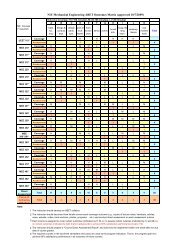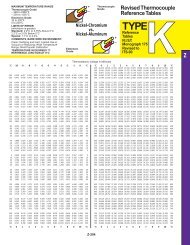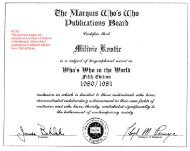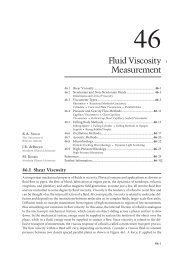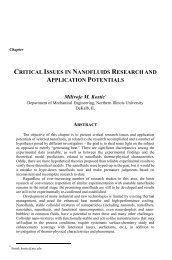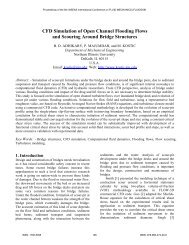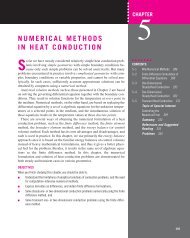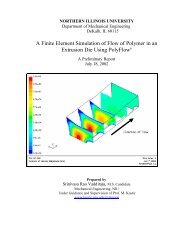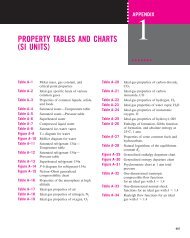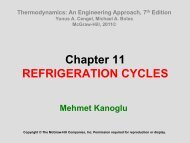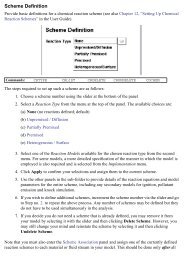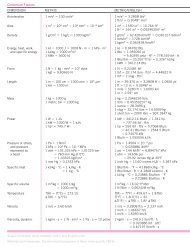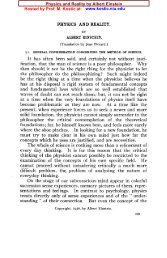Design of Extrusion Dies - Kostic - Northern Illinois University
Design of Extrusion Dies - Kostic - Northern Illinois University
Design of Extrusion Dies - Kostic - Northern Illinois University
Create successful ePaper yourself
Turn your PDF publications into a flip-book with our unique Google optimized e-Paper software.
648 <strong>Design</strong> <strong>of</strong> <strong>Extrusion</strong> <strong>Dies</strong><br />
Avoid thick and nonuniform extrudate wall thickness<br />
to achieve better flow balance control in the<br />
die, minimize material use, reduce cooling times,<br />
and minimize postextrusion warping <strong>of</strong> the product.<br />
Avoid or minimize hollow pr<strong>of</strong>iles as they increase<br />
die fabrication costs and complicate the cooling<br />
process <strong>of</strong> the extrudate.<br />
Except for circular dies, it is virtually impossible to<br />
design a die geometry to achieve a quality extrudate<br />
product for a wide range <strong>of</strong> polymers and extrusion<br />
process conditions. That is why a good die design must<br />
incorporate appropriate adjustment features to be set<br />
(or tuned) during the extrusion process to compensate<br />
for the deficiency <strong>of</strong> the final product, i.e., the cooled<br />
extrudate. For a fixed die geometry, adjustment <strong>of</strong><br />
the deficient pr<strong>of</strong>ile may be achieved by changing<br />
extrusion process parameters, like temperature, flow<br />
rate, cooling rate, and=or take-up speed. However, it<br />
is important to optimize the die design to make the<br />
necessary adjustments practically possible. This is<br />
why polymer extrusion die design has most <strong>of</strong>ten relied<br />
on experience, empirical data, and expensive trial and<br />
error adjustments to design and optimize a die and<br />
complementary process parameters. However, by integrating<br />
computational simulation with empirical data<br />
and by improving the extrusion monitoring instrumentation<br />
the die design process can be improved. A better<br />
die design method yields improved product quality and<br />
a reduction in the time to design and optimize the<br />
extrusion process, resulting in lower costs. It is important<br />
to state again that computational simulation and<br />
empirical extrusion engineering are synergistic in<br />
nature. They have their exclusive strengths and<br />
weaknesses that cannot replace each other, but, if<br />
properly integrated, may significantly improve extrusion<br />
die design.<br />
REFERENCES<br />
1. Tadmor, Z.; Gogos, C.G. Die forming. In Principles<br />
<strong>of</strong> Polymer Processing; John Wiley & Sons,<br />
1979; 521–524.<br />
2. Rosato, D.V. Die design and performance. In<br />
Extruding Plastics; Chapman & Hall, 1998;<br />
228–282.<br />
3. Rauwendaal, C. Die forming. In Understanding<br />
<strong>Extrusion</strong>; Hanser, 1998; 107–109.<br />
4. Tadmor, Z.; Gogos, C.G. Polymer melt rheology.<br />
In Principles <strong>of</strong> Polymer Processing; John Wiley<br />
& Sons, 1979; 148–172.<br />
5. Michaeli, W. Monoextrusion dies for thermoplastics.<br />
In <strong>Extrusion</strong> <strong>Dies</strong> for Plastics and Rubber,<br />
2nd Ed.; Hanser, 1992; 195–198.<br />
6. Woei-Shyong, L.; Hsueh-Yu, H. Experimental<br />
study on extrudate swell and die geometry <strong>of</strong><br />
pr<strong>of</strong>ile extrusion. J. Polym. Eng. Sci. 2000, 40 (5),<br />
1085–1094.<br />
7. Polyflow (application s<strong>of</strong>tware); Fluent Inc.:<br />
Lebanon, NH; http:==www.fluent.com=s<strong>of</strong>tware=<br />
polyflow (accessed Mar 2005).<br />
8. Flow 2000; Compuplast International: Zlin,<br />
Czech Republic; http:==www.compuplast.com=<br />
FLOW_2000.htm (accessed Mar 2005).<br />
9. Dieflow: Chippewa Falls WI; http:==www.<br />
dieflow.com (accesses Mar 2005).<br />
10. HyperXtrude, Altair Engineering, Inc.: Troy, MI;<br />
http:==www.altair.com=s<strong>of</strong>tware=hw_hx.htm<br />
(accessed Mar 2005).<br />
11. Michaeli, W. Monoextrusion dies for thermoplastics.<br />
In <strong>Extrusion</strong> <strong>Dies</strong> for Plastics and Rubber,<br />
2nd Ed.; Hanser, 1992; 128–194.<br />
12. Levy, S.; Carley, J.F. <strong>Extrusion</strong> dies for specific<br />
product lines. In Plastics <strong>Extrusion</strong> Technology<br />
Handbook, 2nd Ed.; Industrial Press, Inc., 1989;<br />
96–139.<br />
13. <strong>Extrusion</strong> <strong>Dies</strong> Industries, LLC: Chippewa Falls,<br />
WI; http:==www.extrusiondies.com (accessed<br />
Mar 2005).<br />
14. Michaeli, W. Monoextrusion dies for thermoplastics.<br />
In <strong>Extrusion</strong> <strong>Dies</strong> for Plastics and Rubber,<br />
2nd Ed.; Hanser, 1992; 147–148.<br />
15. Levy, S.; Carley, J.F. On-line and computer control<br />
<strong>of</strong> the extrusion process. In Plastics <strong>Extrusion</strong><br />
Technology Handbook, 2nd Ed.; Industrial Press,<br />
Inc., 1989; 302–304.<br />
16. Tadmor, Z.; Gogos, C.G. Die forming. In Principles<br />
<strong>of</strong> Polymer Processing; John Wiley & Sons,<br />
1979; 533–537.<br />
17. Michaeli, W. Coextrusion dies for thermoplastics.<br />
In <strong>Extrusion</strong> <strong>Dies</strong> for Plastics and Rubber, 2nd<br />
Ed.; Hanser, 1992; 234–238.<br />
18. Levy, S.; Carley, J.F. <strong>Extrusion</strong> dies for specific<br />
product lines. In Plastics <strong>Extrusion</strong> Technology<br />
Handbook, 2nd Ed.; Industrial Press, Inc., 1989;<br />
228–233.<br />
19. Gifford, W.A. A three-dimensional analysis <strong>of</strong><br />
coextrusion in a single manifold flat die. J. Polym.<br />
Eng. Sci. 2000, 40 (9), 2095–2100.<br />
20. Michaeli, W. Coextrusion dies for thermoplastics.<br />
In <strong>Extrusion</strong> <strong>Dies</strong> for Plastics and Rubber, 2nd<br />
Ed.; Hanser, 1992; 215–221.<br />
21. Levy, S.; Carley, J.F. <strong>Extrusion</strong> dies for specific<br />
product lines. In Plastics <strong>Extrusion</strong> Technology<br />
Handbook, 2nd Ed.; Industrial Press, Inc., 1989;<br />
188–213.<br />
22. Michaeli, W. Calibration <strong>of</strong> pipes and pr<strong>of</strong>iles. In<br />
<strong>Extrusion</strong> <strong>Dies</strong> for Plastics and Rubber, 2nd Ed.;<br />
Hanser, 1992; 311–326.



